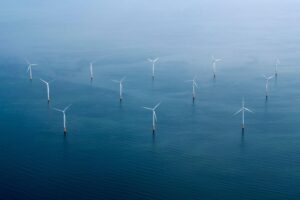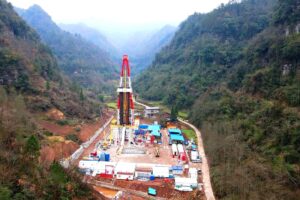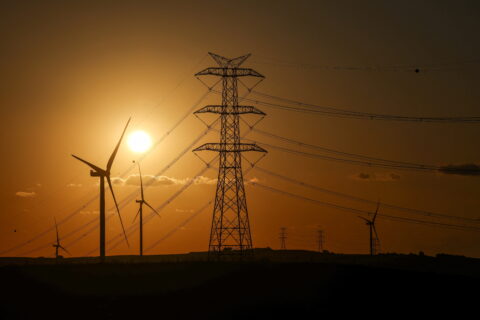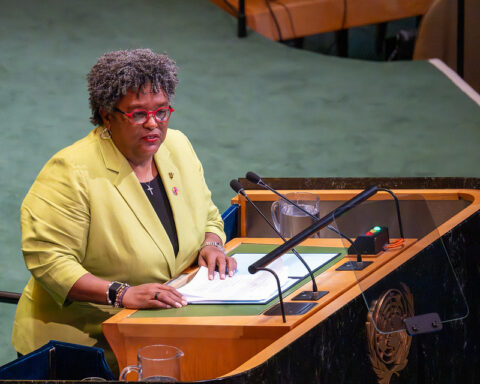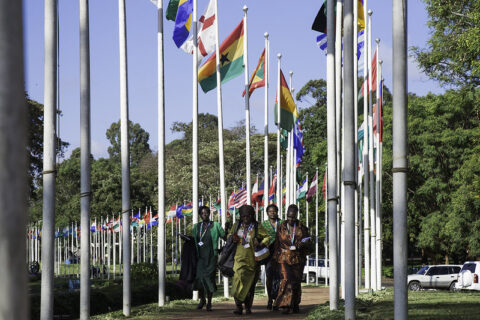Welcome to Carbon Brief’s DeBriefed.
An essential guide to the week’s key developments relating to climate change.
This week
Australia votes for climate action
CLIMATE PROMISE: Australia’s Labor party has secured a second term in power following a landslide election victory, reported CNN. Prime minister Anthony Albanese “reiterated his commitment to climate action” and his government’s target to reach net-zero by 2050, added the outlet. Bloomberg said Albanese’s “next campaign” is to stave off Turkey to secure hosting the COP31 climate summit, along with Pacific nations, in 2026.
PUBLIC SUPPORT: The Conversation said that Australia now has “five huge climate opportunities”, including setting an ambitious new international climate pledge for 2035. Columnist David Fickling wrote in Bloomberg that the “historic” victory of the Labor party proved the right-wing opposition party’s plan to replace “renewables-focused climate targets with a switch to nuclear energy” was not widely supported. Guardian Australia’s climate and environment editor Adam Morton said that the country “backed a rapid shift to renewable energy”.
EU eyes renewable future
RUSSIAN GAS: The European Commission published a “roadmap” for ending reliance on Russian energy, which includes a ban on all Russian gas imports by the end of 2027, BBC News reported, adding that the bloc hopes to move away by “accelerating the deployment of renewable energy”. Meanwhile, Chinese president Xi Jinping was expected to talk about the China-Russia Siberia 2 gas pipeline, which could send 50bn cubic metres of gas to China, during his visit to Moscow this week, the Guardian reported.
SPAIN’S TRANSITION: Following last week’s blackout in Spain and Portugal, the Spanish prime minister Pedro Sánchez said that he will not deviate a “single millimetre” from his commitment to renewable energy, calling it “our country’s energy future” and “our only and best option”, reported the Financial Times. Sanchez rejected nuclear-power advocates, saying the blackout was used as an excuse for a “gigantic manipulation exercise”, reported the Daily Telegraph.
Trump regime continues
DISASTERS DELETED: The New York Times reported that the US National Oceanic and Atmospheric Administration (NOAA) has announced that it will stop tracking the cost of the country’s most expensive disasters – defined as those that cause at least $1bn in damage. The newspaper described this as the “latest effort from the Trump administration to restrict or eliminate climate research”.
MORE TRUMP: The Trump administration also proposed to cut more than $21bn in climate-related funding, including $15bn for carbon capture and renewable energy and $6bn for electric-vehicle chargers, reported Reuters. Elsewhere, two major science unions pledged to produce “over 29 peer-reviewed journals that will cover all aspects of climate change” after the administration dismissed a “key Congress-mandated report on climate”, reported the Guardian.
Around the world
- UN REFORM: The UN is “considering sweeping reforms”, which could “integrate” the “climate change arm” into the “environment programme”, following “even deeper funding cuts” from the Trump administration, said the Financial Times. The newspaper added that the reform memo also “mulled whether the COP climate change summit…‘should be discontinued’ in its current form”.
- WINDFARM BLOW: The construction of Hornsea 4, a windfarm that aimed to add 2.4GW to the UK’s clean energy capacity, was cancelled by its Danish owner Ørsted, reported BBC News. The Guardian said the decision was a “major blow to the government’s plan to quadruple the UK’s offshore wind capacity by the end of the decade”.
- CHINA EXTREME WEATHER: Upcoming “hot and dry” weather will pose risks to the wheat harvest in China’s Henan province, which accounted for nearly a third of the nation’s total wheat output in 2024, Bloomberg reported.
- METHANE EMISSIONS: Record fossil-fuel production pushed methane emissions close to an all-time high in 2024, according to a report by the International Energy Agency, covered by Agence France-Presse.
65%
The proportion of global warming from 1990-2020 that the “wealthiest 10%” of people are “responsible” for, according to research covered by Carbon Brief.
Latest climate research
- Research in PLOS Climate found that just 4% of hyperlinks point to “scientific sources” in 1.3m posts and 20.3m comments related to climate change on Reddit from 2009-22.
- Climate change intensified deadly rainfall and made storms more likely to occur in Arkansas, Kentucky, Tennessee and other states across the US south and midwest in early April, a new World Weather Attribution analysis found.
- Science Advances published a study finding that an unprecedented surge in concurrent heatwave-drought events from Eastern Europe to East Asia has been “amplified” by climate change.
For more, see Carbon Brief’s in-depth daily summaries of the top climate news stories on Tuesday, Wednesday, Thursday and Friday.)
Captured

Children born in 2020 – of which there are about 124 million – will face “unprecedented exposure” to extreme weather events, even if global warming is limited to 1.5C by the end of the century, according to a new study published in Nature and covered by Carbon Brief. The chart above illustrates how many millions of children born in 2020 are expected to face a range of extremes, from heatwaves to tropical cyclones, throughout their lifetime at 1.5C (dark blue), compared to even higher levels of warming. Limiting global warming to 1.5C could save 77.2 million children from exposure to extremes, the research concluded.
Spotlight
Taiwan’s nuclear phaseout
This week, Carbon Brief examines what Taiwan’s decision to phase out nuclear power means for its climate policies.
Taiwan will shut down its last nuclear power reactor on 17 May.
Nuclear has played an important role in Taiwan’s energy supply, which is 97% imported.
Nuclear provided 12% of electricity in 2016, according to the Taiwanese Energy Administration. In 2025, it accounted for about 3% of the electricity supply, while gas contributed 46%, coal 34% and renewable energy 15%.
In 2016, the Democratic Progressive Party (DPP), an anti-nuclear party, won the presidential election. Then-president Tsai Ing-wen launched her “nuclear-free homeland policy”, with a pledge to avoid nuclear incidents similar to the Fukushima disaster in Japan.
The DPP has said that going “nuclear-free” is part of its “net-zero” transition. The party aims to have 50% of its electricity generated from gas, 30% from coal and 20% from renewable sources by 2025.
Public concerns
Nevertheless, its nuclear-free policy faces pressures from the opposition parties, as well as the public.
The Taipei Times, a Taiwanese newspaper, reported that 48% of the public was “dissatisfied” with the plan in 2017.
Protests against the plan continued until May 2025, with many people citing worries about having a stable electricity supply.
Seeking to reassure the public, the government’s Energy Administration said that the need to source more electricity to replace nuclear has “already been included in the long-term electricity development plan” and that “there will be no power shortage”.
More fossil fuels?
The environmental impact of the government’s “long-term power electricity plan” has also been under scrutiny.
The Taipei Times said the plan is “substituting nuclear sources of energy with coal-fired sources”.
A study in Energy Strategy Review found that the plan “lack[s]” a “coal phase-out schedule”, which may “render Taiwan’s energy transition unjust”.
In 2016, about 45.9% of electricity supply was from coal, while gas and renewable energy accounted for 31.5% and 4.8% respectively.
Rather than gradually reducing coal-fired power as the DPP planned, the share of coal increased to more than 47% in 2018, which then fell back to 45% in 2020, due to the temporary increase of nuclear power, said the study.
The growth of gas and renewable sources did not go as fast as the DPP predicted, according to the study, making the nuclear-free energy transition “unlikely to be achieved”.
As of today, only 14.6% of electricity in Taiwan is from renewable sources, far behind its goal of 20%.
Meanwhile, burning gas, which is the main energy source under the plan, releases carbon emissions, making it harder for the island to achieve net-zero.
Focus Taiwan said the move could promote the use of fossil fuels to as high as 84%.
The official nuclear research institute National Atomic Research Institute in Taiwan refused a request to comment.
Watch, read, listen
WEATHER AND PANGOLINS: A TEDxLondon podcast focused on how crop failure, drought and extreme weather are damaging the livelihood of pangolins.
DEEP DIVE: A new feature-length documentary “Ocean With David Attenborough” is in cinemas now.
US AND CLIMATE: An editorial in the Break-Down, a new publication focusing on the “political economy of climate and ecological crisis”, dissects “this moment in climate politics”.
Coming up
- 10-11 May: 2025 international workshop on methane observation and quantification, Xuzhou, China
- 12 May: Philippines elections
- 12-14 May: African Union conference on debt, Lomé, Togo
- 14 May: NDC partnership public webinar, online
Pick of the jobs
- BBC World Service, science/climate journalist and senior science/climate journalist | Salary: £28,000-£35,000 and £42,000-£49,000. Location: London
- Global Renewables Alliance, various roles | Salary: Unknown. Location: Various
- EarthRights International, Mekong communications manager | Salary: Unknown. Location: Chiang Mai, Thailand
DeBriefed is edited by Daisy Dunne. Please send any tips or feedback to debriefed@carbonbrief.org.
This is an online version of Carbon Brief’s weekly DeBriefed email newsletter. Subscribe for free here.
The post DeBriefed 9 May 2025: Australia elects climate action; Spain ‘committed’ to renewables; Taiwan’s nuclear phaseout appeared first on Carbon Brief.
Climate Change
IEA: Renewables have cut fossil-fuel imports for more than 100 countries
More than 100 countries have cut their dependence on fossil-fuel imports and saved hundreds of billions of dollars by continuing to invest in renewables, according to the International Energy Agency (IEA).
It says nations such as the UK, Germany and Chile have reduced their need for imported coal and gas by around a third since 2010, mainly by building wind and solar power.
Denmark has cut its reliance on fossil-fuel imports by nearly half over the same period.
Renewable expansion allowed these nations to collectively avoid importing 700m tonnes of coal and 400bn cubic metres of gas in 2023, equivalent to around 10% of global consumption.
In doing so, the fuel-importing countries saved more than $1.3tn between 2010 and 2023 that would otherwise have been spent on fossil fuels from overseas.
Reduced reliance
The IEA’s Renewables 2025 report quantifies the benefits of renewable-energy deployment for electricity systems in fossil fuel-importing nations.
It compares recent trends in renewable expansion to an alternative “low renewable-energy source” scenario, in which this growth did not take place.
In this counterfactual, fuel-importing countries stopped building wind, solar and other non-hydropower renewable-energy projects after 2010.
In reality, the world added around 2,500 gigawatts (GW) of such projects between 2010 and 2023, according to the IEA, more than the combined electricity generating capacity of the EU and US in 2023, from all sources. Roughly 80% of this new renewable capacity was built in nations that rely on coal and gas imports to generate electricity.
The chart below shows how 31 of these countries have substantially cut their dependence on imported fossil fuels over the 13-year period, as a result of expanding their wind, solar and other renewable energy supplies. All of these countries are net importers of coal and gas.

In total, the IEA identified 107 countries that had reduced their dependence on fossil fuel imports for electricity generation, to some extent due to the deployment of renewables other than hydropower.
Of these, 38 had cut their reliance on electricity from imported coal and gas by more than 10 percentage points and eight had seen that share drop by more than 30 percentage points.
Security and resilience
The IEA stresses that renewables “inherently strengthen energy supply security”, because they generate electricity domestically, while also “improving…economic resilience” in fossil-fuel importer countries.
This is particularly true for countries with low or dwindling domestic energy resources.
The agency cites the energy crisis exacerbated by Russia’s invasion of Ukraine, which exposed EU importers to spiralling fossil-fuel prices.
Bulgaria, Romania and Finland – which have historically depended on Russian gas for electricity generation – have all brought their import reliance close to zero in recent years by building renewables.
In the UK, where there has been mounting opposition to renewables from right-wing political parties, the IEA says reliance on electricity generated with imported fossil fuels has dropped from 45% to under 25% in a decade, thanks primarily to the growth of wind and solar power.
Without these technologies, the UK would now be needing to import fossil fuels to supply nearly 60% of its electricity, the IEA says.
Other major economies, notably China and the EU, would also have had to rely on a growing share of coal and gas from overseas, if they had not expanded renewables.
As well as increasing the need for fossil-fuel imports from other countries, switching renewables for fossil fuels would require significantly higher energy usage “due to [fossil fuels’] lower conversion efficiencies”, the IEA notes. Each gigawatt-hour (GWh) of renewable power produced has avoided the need for 2-3GWh of fossil fuels, it explains.
Finally, the IEA points out that spending on renewables rather than imported fossil fuels keeps more investment in domestic economies and supports local jobs.
The post IEA: Renewables have cut fossil-fuel imports for more than 100 countries appeared first on Carbon Brief.
IEA: Renewables have cut fossil-fuel imports for more than 100 countries
Climate Change
Panama environment minister backs calls for reform of UN climate process
Panama’s environment minister has joined a growing push for reform of the UN climate change negotiations, proposed by campaigners and academics in recent years – one of the first such calls by a minister directly involved in the talks.
Juan Carlos Navarro told Climate Home in a recent interview on the sidelines of Climate Week in New York that the current system for approving decisions – which requires all countries to agree by consensus – has not delivered good enough results and should instead use a majority or super-majority decision-making process.
“By consensus, you cannot get 186 nations to agree on anything. It’s a miracle we have come so far,” said Navarro. “We need to change the rules so we have a basic, rational, majority or super-majority decision-making process where we can do things better and faster.”
The comments follow pressure from civil society and academics to reform the UN climate process. In June, more than 200 campaign groups issued a joint call to reform the decision-making process, which they argued can be blocked by oil and gas-producing countries and has reached a “breaking point”.
Andreas Sieber, policy director with climate advocacy group 350.org, said he was sympathetic to Panama’s proposal, but added “it would just be part of a puzzle” to make the UN climate talks work more efficiently.
He added that it could be hard to get over the line as earlier efforts to secure a rule on voting as a last resort had met with fierce opposition from oil-producing countries – and decisions reached by consensus have the weight of having all the countries behind them, he noted.
Erika Lennon, Senior Attorney at the Center for International Environmental Law, celebrated that more people are talking about potential changes to the UNFCCC, as “being totally beholden to consensus-based decision making is not leading to the outcomes that we need”.
She also agreed that voting is just part of the solution, and suggested possible reforms could include increased transparency in the negotiation rooms, inclusion of civil society and indigenous groups, and a conflict of interest rule that blocks fossil fuel companies from participating.
During last year’s COP29 in Baku, a group of experts known as the Club of Rome – among them the former UN climate chief Christiana Figueres and former UN Secretary-General Ban Ki Moon – issued an open letter proposing ways to modernise the climate process.
The current structure of COPs “simply cannot deliver the change at exponential speed and scale, which is essential to ensure a safe climate landing for humanity”, the letter said. They argued instead for “smaller, more frequent, solution-driven meetings” where countries can discuss progress and be held accountable.
At that same COP in Azerbaijan, Saudi Arabia managed to block all mentions of fossil fuels in text summarising discussions on cutting greenhouse gas emissions. It was able to do this despite all countries having agreed to transition away from fossil fuels in energy systems just one year earlier at COP28.
UN Climate Change consults on COP process
In a speech at Climate Week in New York, Simon Stiell, the executive secretary of UN Climate Change, noted that recent COPs have delivered “concrete results and global steps forward”, adding that cooperation under the process has lowered expected global warming from 5C to closer to 3C.
But, he conceded, it is “imperfect”. “As this new era of implementation gathers pace, we must also keep evolving, and striving towards faster, fully-inclusive, higher-quality decisions that tie the formal process ever-closer to real economies and real lives,” he said.
Senior experts have been asked to examine how the UN climate process could be improved and will deliver their ideas to Stiell later this year. The secretariat will consult with countries on any potential reforms it wants to pursue in 2026, the UN’s climate chief added.
Brazil, the host country of this year’s COP, has put the focus on global mobilisation to implement in practice what governments signed up to in the 2015 Paris Agreement. Last year it proposed setting up a UN Climate Change Council in order to support that work, but this proposal does not seem to have gained much traction amid geopolitical tensions and Trump’s attacks on multilateral climate action.

Downsizing COPs?
Panama’s Navarro added that the UN climate summit has grown too big, making its scope “ridiculous”. In 2023, over 83,000 people attended COP28 in Dubai, while COP29 in Baku saw fewer, with 66,778 registered participants.
Navarro said the COP meetings had become an anachronism. “You have thousands and thousands of people who are living off the story,” he said. “They’re living off these meetings, just sitting around the world on expense accounts, creating a bigger carbon footprint for the planet, and we’re not achieving anything.”
In April 2024, UNFCCC head Stiell said personally he “would certainly like to see future COPs reduce in size”, telling an audience at London’s Chatham House think-tank that “bigger doesn’t necessarily mean better”.
This year, COP30 will be held in the Amazon city of Belem, which poses “self-evident” financial and logistical limitations, according to Navarro, who praised Brazil for being open to hearing the complaints from the Global South countries on this topic.
After many delegations complained over the high costs of accommodation and difficult access, Brazil offered cruise-ship rooms and price caps, and the UN has increased the daily subsidy for diplomats from most developing nations to attend the summit.
Landmark ICJ climate ruling must be turned into concrete action on shipping
‘Less hypocrisy, more concrete results’
“Having said that, and coming back to the point of what COPs have become, I wish that COPs were less bullshit, more concrete results,” Navarro told Climate Home.
His own country – which is judged to be carbon-negative, thanks to its extensive carbon-storing forests – recently published its “Nature Pledge”, combining climate, biodiversity and conservation pledges. Those include restoring 100,000 hectares of ecosystems such as degraded mangroves by 2035, maintaining 30% of Panama’s land and seas under protection and absorbing 5 million tons of CO₂.
Practical measures to achieve that include new equipment for park rangers, more radars to monitor and catch illegal fishing, and fines for polluting industries.
Panama has also set up a Nature Fund, which aims to collect $150 million-$200 million for conservation projects using resources like blue carbon bonds, debt-for-nature swaps and a national carbon market backed by blockchain with revenues going to the public sector to ensure “transparency and accountability”.
Without specifying which, Navarro called out “countries that do an incredible job of greenwashing, talking about conservation and talking about the environment – and they’re either oil producers or plastics producers, or kill whales or are destroying our fisheries, or keep building coal power plants or keep polluting”.
“We’ve run out of time for all of these hypocritical individuals, corporations – or even nations,” he added.
The post Panama environment minister backs calls for reform of UN climate process appeared first on Climate Home News.
Panama environment minister backs calls for reform of UN climate process
Climate Change
AI and satellite data help researchers map world’s transition minerals rush
Researchers are using satellite images and AI-powered modelling to map global mining activity, seeking to plug gaps in existing data as the rush for “transition minerals” fuels concerns about the industry’s impact on the environment and local communities.
Countries are scrambling to shore up supplies of metals vital for the transition to renewables, such as lithium used in electric vehicle (EV) batteries, and copper – used in solar panels and wind turbines, many of which are produced in environmentally sensitive areas.
“New mines will likely be in areas of high biodiversity, or where water and Indigenous rights are at stake,” project lead Victor Maus from the Vienna University of Economics and Business told Climate Home News.
More than half of energy transition mineral resources are located on or near the lands of Indigenous peoples and subsistence farmers, according to a 2022 study published in the Nature journal.
“Monitoring those impacts is critical,” said Maus, whose team members have identified massive gaps in current data when it comes to what, how and even where minerals are being extracted around the world.
During a previous project, they compared global satellite imagery of 120,000 square kilometres of visible mine footprints with the S&P Capital IQ Pro database of mining production. The results were stark. More than half of the mining areas identified from space had no corresponding production data in the official record.
To address these gaps, Maus and his team are building a mining database using satellite images. The project, which is part of the European Union-funded Mine the Gap initiative, will be a vital tool for policymakers and help foster transparency in the mining industry, he added.
“We’re hoping to create not only a research tool but also a means of validating and complementing what companies report, supporting greater transparency across the sector.”
Mapping environmental impact
As well as counting mines and assessing overall production, the database will give a clearer picture about where the biggest environmental and social risks lie by tracking land use around mines, waste generation and signs of environmental degradation.
“Simply knowing how much is being produced isn’t a direct measurement of impact,” said Tim Werner, a senior lecturer at The University of Melbourne who has worked with Maus on previous research into critical minerals.
“We simply don’t have all the information we need to scientifically prove where impacts for one area are worse than others. This is a big problem for strategic environmental management at national and global scales,” he added, describing the data gaps as “mind-boggling”.
A range of satellites are being used to collect the required information, including multispectral imagery, radar and hyperspectral sensors, collected from sources including the EU’s Sentinel constellation and German DLR satellites, chosen for their global coverage and accuracy.
AI will then be used to scan these images, learning how to identify and track potential issues as the project develops.
The challenges of collecting mining data
There have been previous attempts to map the overlap between energy transition mineral mines and key biodiversity hotspots in different mineral-rich countries, as well as industry efforts to plug the gaps in data about global mining production.
But past efforts to map global mining more accurately have struggled to document small-scale and artisanal mining operations, which are often unregulated despite their significant social and environmental impacts.
In September, the International Council on Mining and Metals (ICMM) launched its global mining database – reportedly the most comprehensive mining resource to date, with information about more than 15,000 active facilities in 151 countries, but it does not include informal mining sites.
“We had to draw some scope boundaries,” said Emma Gagen, the ICMM’s data and research director. “The industry is huge and that’s been the challenge this whole time – people haven’t tried to collect this data before because it’s so vast.”
The case for clearer global standards
Despite such data initiatives, which reflect growing pressure on the industry to clean up its act, researchers say structural and legislative changes will be needed to reduce the harms caused by mining.
Gagen said more uniform regulatory standards would “drive performance improvements across the industry.”
“What’s most needed is alignment,” Maus said. “Clearer global standards on what should be measured and reported, and policies that encourage disclosure of mining data.”
For Maus and his team, having an accurate picture is a crucial first step.
“If we don’t even know how many materials are being produced, we’ve got very little basis to even understand the scale of possible impacts in an area,” Werner said.
Main image: Satellite image showing the expansion of nickel mining in Sulawesi, Indonesia (Photo: Sentinel-2 cloudless by EOX IT Services GmbH, which contains modified Copernicus Sentinel data 2024)
The post AI and satellite data help researchers map world’s transition minerals rush appeared first on Climate Home News.
AI and satellite data help researchers map world’s transition minerals rush
-
Climate Change2 years ago
Spanish-language misinformation on renewable energy spreads online, report shows
-
Climate Change2 months ago
Guest post: Why China is still building new coal – and when it might stop
-
Climate Change Videos2 years ago
The toxic gas flares fuelling Nigeria’s climate change – BBC News
-

 Greenhouse Gases1 year ago
Greenhouse Gases1 year ago嘉宾来稿:满足中国增长的用电需求 光伏加储能“比新建煤电更实惠”
-

 Climate Change1 year ago
Climate Change1 year ago嘉宾来稿:满足中国增长的用电需求 光伏加储能“比新建煤电更实惠”
-
Greenhouse Gases2 months ago
Guest post: Why China is still building new coal – and when it might stop
-

 Carbon Footprint2 years ago
Carbon Footprint2 years agoUS SEC’s Climate Disclosure Rules Spur Renewed Interest in Carbon Credits
-
Renewable Energy3 months ago
US Grid Strain, Possible Allete Sale




